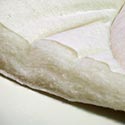Every purchase made online is encrypted with a high level of security you’ve come to expect. Your private information is never shared nor sold, so you can buy with confidence. You can also visit our store if you are in the St. Louis area.

So what’s the difference between organically grown cotton and regular conventional cotton? Today’s blog on cotton will show you the differences in farming methods including seed preparation, soil, and water management, weed control, insects, and a few other cotton farming tidbits you may find helpful in your search for no toxic chemicals cotton.
Table of Contents
A couple of little tidbits on seed preparation for both conventional and organic cotton:
In the preparation of everyday conventional cotton that you and I are most familiar with and have grown-up with is farmed with cottonseeds that are treated using insecticides and fungicides in addition to that 70 percent of all the cotton grown in the United States uses GMO {Genetically Modified Organisms}.
Alternatively organic cotton never uses {GMO} and their seeds are untreated with the potentially harmful insecticides and fungicides.
Soil and water tidbits:
The conventional method of growing cotton puts down synthetic fertilizers whereas organic cotton builds strong soil through well-monitored crop rotation.
There is a predominate loss of soil due to mono-crop culture and necessitates exhaustive irrigation. Organic cotton methods preserve, retain, and maintain water more efficiently thanks to additional organic matter within the soil.
More tidbits on weed control:
In conventional methods of farming cotton, the farmer is able to reduce weed germination by using herbicides that are applied to the soil. Repeated follow-up applications are used to kill weeds that zap the soil of nutrients and moisture.
Weeds are removed physically rather than by the application of chemicals. Additional weed control comes from hoeing by hand and cultivation.
Tidbits about pest control:
Around 25 Percent of the worlds insecticide consumption comes by way of cotton.
9 highly toxic pesticides, 5 of which are known Carcinogens are commonly used in growing cotton.
Drift from aerial spraying contaminates farmworkers, neighboring wildlife, and entire communities.
An organic method of pest control utilizes a healthy maintained balance between pests and their natural predators. This is done through healthy soil. The use of helpful insects can be beneficial, in addition to cultural, and biological practices to control pests. Organic farmers sometimes use a trap crop which is planted to lure harmful insects away from their otherwise unprotected cotton.
Informational tidbits on harvesting:
Lastly, the harvesting of conventional cotton uses toxic chemicals to defoliate cotton plants. Organic farming methods of defoliation relies on the seasonal freeze or can also be defoliated through water management.
STL Beds used only certified organic cotton in the production of their organic mattresses. Sleeping on a mattress that uses synthetic fibers or non-organically grown cotton could potentially expose you or your family to toxic chemical anywhere from 6-9 hours a night through inhalation or absorption.
